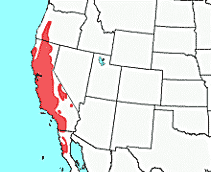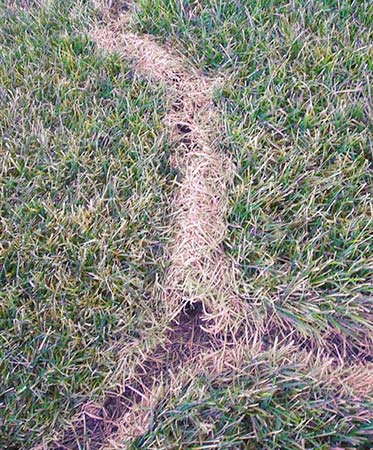
Habitat
The California Meadow Vole is essentially named after the region
in which they are found. Microtus californicus is found in the
majority of California witch ranges from Eugene, Oregon to El
Rosario, Baja California, Mexico (Cudworth and Koprowski 2010).

There are many different species which are
found throughout the country (McGuire 2011). As mentioned in 2002 on
Animal Diversity Web by Peronne, Microtus californicus is found in
the northern part of Baja California to central Oregon. These voles
tend to live in grasslands, woodlands, and shrub lands in this
region. This specific species of vole seem to choose very different
conditions and habitats to live in compared to other species. They
differ in the fact that in some cases, they choose to live in marshy
ground, saltwater and freshwater locations, wet meadows, coastal
wetlands and dry, grassy hillsides (ADW 2002). Microtus californicus is also
recently known to live on Brooks Island, San Francisco Bay, California. The
vegetation here is shrub-savannah type and very similar to the
habitat on the mainland of California (Anderson and Lidicker 1962).
The climate in the San Francisco Bay area is Mediterranean which
means there are moderate temperatures throughout the year and winter
is the wet season from December to June (Anderson and Lidicker
1962). During the dry season the voles tend to eat the seeds and
roots because they do not have green vegetation to eat (Anderson and
Lidicker 1962).
 California
Meadow Voles are semifossorial which means they live partially
underground in burrows. They inhabit grass runways, burrows, and
earth tunnels (ADW 2002). There usually is only one opening to
these burrows and they are made from cut grass shaped into a ball
(Cudworth and Koprowski 2010). They use these runways to move
through the regions they live in and also to track others. They
track other voles in these runways by following the scents of feces
and urine of those voles. Their
habitat also determines the size they will be at full growth
(ADW 2002.) Certain areas may cause them to be larger or
smaller. Meadow voles will usually not invade crops until the plants
are tall enough to shelter and cover them (Vertebrate Pest Control
Handbook 2009). These voles are also active all year no matter their
habitat or in which region they live (Vertebrate Pest Control
Handbook 2009).
California
Meadow Voles are semifossorial which means they live partially
underground in burrows. They inhabit grass runways, burrows, and
earth tunnels (ADW 2002). There usually is only one opening to
these burrows and they are made from cut grass shaped into a ball
(Cudworth and Koprowski 2010). They use these runways to move
through the regions they live in and also to track others. They
track other voles in these runways by following the scents of feces
and urine of those voles. Their
habitat also determines the size they will be at full growth
(ADW 2002.) Certain areas may cause them to be larger or
smaller. Meadow voles will usually not invade crops until the plants
are tall enough to shelter and cover them (Vertebrate Pest Control
Handbook 2009). These voles are also active all year no matter their
habitat or in which region they live (Vertebrate Pest Control
Handbook 2009).
Microtus
californicus does not occupy all of California but rather specific
home ranges. The home ranges of these species varies between 68
meters squared and 103 meters squared. When the population density
of the in these home ranges is low they can become
temporarily extinct. Also,
their survival rates seem to decrease in the summer months
specifically June and July because mortality rate increases due to
very dry weather. This dry weather shows that the habitat they live
in can have a large impact on their populations. (Cudworth and
Koprowski 2010).
Next, read about the Form and Function of the California Meadow Vole.